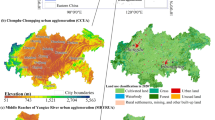Abstract
Urban expansion is a phenomenon of urban space increase, and an important measuring index of the process of urbanization. Taking Shanghai as an example, the changes of urban average height and built-up area were studied to represent city’s vertical and horizontal increases respectively, and statistical methods were used to analyze the driving forces of urban expansion. The research drew following conclusions: 1) The urban expansion process of Shanghai from 1985 to 2006 had a clear periodic feature, and could be divided into three stages: vertical expansion in dominance, coordinated vertical and horizontal expansion, and horizontal expansion in dominance. 2) The average height and quantity of buildings in core city were significantly bigger than those in suburbs, but the changing speed of the latter was faster. And 3) urbanization process was the major driving force for the city’s horizontal expansion, while industrial structure improvement was the key driving factor for the vertical expansion. Those two driving forces were simultaneously affected by city’s political factors.
Similar content being viewed by others
References
Aguilar A G, 1999. Mexico City growth and regional dispersal: The expansion of largest cities and new spatial forms. Habitat International, 23(3): 391–412. DOI: 10.1016/S0197-3975(99)00014-4
Alig R J, Kline J D, Lichtenstein M, 2004. Urbanization on the US landscape: Looking ahead in the 21st century. Landscape and Urban Planning, 69(2–3): 219–234. DOI: 10.1016/j.landu-rbplan.2003.07.004
Alfred M, 1890. Principles of Economics (8th ed.). London: MacMillan & Co., 371.
Cheng J Q, Masser I, 2003. Urban growth pattern modeling: A case study of Wuhan City, P R China. Landscape and Urban Planning, 62(4): 199–217. DOI: 10.1016/S0169-2046(02)00-150-0
Fan C C, 1999. The vertical and horizontal expansions of China’s city system. Urban Geography, 20(6): 493–515. DOI: 10.1016/S0305-9006(01)00022-8
Fang Xiuqi, Zhang Wenbo, Zhang Lansheng et al., 2002. Beijing city expansion and countryside intermediate belt evolvement in recent centuries. Urban Planning, (4): 56–60. (in Chinese)
Hoch I, 1968. The three-dimensional city: Contained urban space. In: Perloff H S (ed.). The Quality of the Urban Environment. Washington: Resources for the Future, Inc., 75–135.
Liu Shuhua, Shen Yufang, 2006. A probe into the urban sprawl model and its drive mechanism in Shanghai. Economic Geography, (3): 487–491. (in Chinese)
Luo Maochu, 1988. Tracing and evaluation of the policy to develop small cities and towns of China. Population Research, (1): 13–18.
Moreira F, Rego F C, Ferreira P G, 2001. Temporal (1958–1995) pattern of change in a cultural landscape of northwestern Portugal: Implications for fire occurrence. Landscape Ecology, 16: 557–567. DOI: 10.1023/A:1013130528470
Peucker T K, 1968. Johann Georg Kohl, A theoretical geographer of the 19th century. Professional Geographer, 20(4): 247–250. DOI: 10.1111/j.0033-0124.1968.00247.x
Rui Jianxun, 2007. Study on the effect of high buildings on the urban thermal landscape in Shanghai. Geography and Geography Information Science, 23(1): 104–108. (in Chinese)
Shanghai Statistical Bureau, 1985–2006. Shanghai Statistical Yearbook. Beijing: China Statistic Press. (in Chinese)
Seto K C, Fragkias M, 2005. Quantifying spatiotemporal patterns of urban land-use change in four cities of China with time series landscape metrics. Landscape Ecology, 20: 871–888. DOI: 10.1007/s10980-005-5238-8
Thomson C, 1966. How high to rise. The Appraisal Journal, 34: 585–591.
Verburg P H, de Koning G H J, Kok K et al., 1999. A spatial explicit allocation procedure for modeling the pattern of land use change based upon actual land use. Ecological Modeling, 116: 45–61. DOI: 10.1016/S0304-3800(98)00156-2
Wang Hualan, Zhou Wei, Wang Yuanqing, 2007. Influence of transportation between central city and satellite city on urban spatial expansion. Journal of Chang’an University (Natural Science Edition), 27(4): 79–83. (in Chinese)
Wright C, 1971. Residential location in a three-dimensional city. Journal of Political Economy, 79: 1378–1387.
Xu Yanxi, Chen Feng, Pu Lijie, 2007. A retrospect and prospect on research of urban spatial and land use expansion. Economic Geography, 27(2): 296–305. (in Chinese)
Xiao Jieying, Shen Yanjun, Ge Jingfeng et al., 2006. Evaluating urban expansion and land use change in Shijiazhuang, China, by using GIS and remote sensing. Landscape and Urban Planning, 75(1–2): 69–80. DOI: 10.1016/j.landurbplan.2004.12.005
Zeng Lei, Zong Yong, Lu Qi, 2004. Spatial-temporal feature of urban land extension in Baoding City. Resources Science, 26(4): 96–103. (in Chinese)
Author information
Authors and Affiliations
Corresponding author
Additional information
Foundation item: Under the auspices of the Key Direction in Knowledge Innovation Programs of Chinese Academy of Sciences (No. KZCX2-YW-422), National Natural Science Foundation of China (No. 40701059)
Rights and permissions
About this article
Cite this article
Shi, L., Shao, G., Cui, S. et al. Urban three-dimensional expansion and its driving forces —A case study of Shanghai, China. Chin. Geogr. Sci. 19, 291–298 (2009). https://doi.org/10.1007/s11769-009-0291-x
Received:
Accepted:
Published:
Issue Date:
DOI: https://doi.org/10.1007/s11769-009-0291-x



